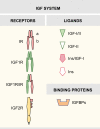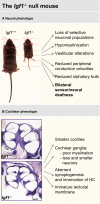The role of insulin-like growth factor-I in the physiopathology of hearing
- PMID: 21845174
- PMCID: PMC3146045
- DOI: 10.3389/fnmol.2011.00011
The role of insulin-like growth factor-I in the physiopathology of hearing
Abstract
Insulin-like growth factor-I (IGF-I) belongs to the family of polypeptides of insulin, which play a central role in embryonic development and adult nervous system homeostasis by endocrine, autocrine, and paracrine mechanisms. IGF-I is fundamental for the regulation of cochlear development, growth, and differentiation, and its mutations are associated with hearing loss in mice and men. Low levels of IGF-I have been shown to correlate with different human syndromes showing hearing loss and with presbyacusis. Animal models are fundamental to understand the genetic, epigenetic, and environmental factors that contribute to human hearing loss. In the mouse, IGF-I serum levels decrease with aging and there is a concomitant hearing loss and retinal degeneration. In the Igf1(-/-) null mouse, hearing loss is due to neuronal loss, poor innervation of the sensory hair cells, and age-related stria vascularis alterations. In the inner ear, IGF-I actions are mediated by intracellular signaling networks, RAF, AKT, and p38 MAPK protein kinases modulate the expression and activity of transcription factors, as AP1, MEF2, FoxM1, and FoxP3, leading to the regulation of cell cycle and metabolism. Therapy with rhIGF-I has been approved in humans for the treatment of poor linear growth and certain neurodegenerative diseases. This review will discuss these findings and their implications in new IGF-I-based treatments for the protection or repair of hearing loss.
Keywords: IGF1R signaling; animal models; deafness; human genetics; insulin-like factors; organ of Corti.
Figures



Similar articles
-
RNA microarray analysis in prenatal mouse cochlea reveals novel IGF-I target genes: implication of MEF2 and FOXM1 transcription factors.PLoS One. 2010 Jan 25;5(1):e8699. doi: 10.1371/journal.pone.0008699. PLoS One. 2010. PMID: 20111592 Free PMC article.
-
A comparative study of age-related hearing loss in wild type and insulin-like growth factor I deficient mice.Front Neuroanat. 2010 Jun 23;4:27. doi: 10.3389/fnana.2010.00027. eCollection 2010. Front Neuroanat. 2010. PMID: 20661454 Free PMC article.
-
Insulin-like Growth Factor 1 Signaling in Mammalian Hearing.Genes (Basel). 2021 Sep 29;12(10):1553. doi: 10.3390/genes12101553. Genes (Basel). 2021. PMID: 34680948 Free PMC article. Review.
-
IGF-1 deficiency causes atrophic changes associated with upregulation of VGluT1 and downregulation of MEF2 transcription factors in the mouse cochlear nuclei.Brain Struct Funct. 2016 Mar;221(2):709-34. doi: 10.1007/s00429-014-0934-2. Epub 2014 Nov 7. Brain Struct Funct. 2016. PMID: 25378055
-
Trophic effects of insulin-like growth factor-I (IGF-I) in the inner ear.Hear Res. 2004 Oct;196(1-2):19-25. doi: 10.1016/j.heares.2003.12.022. Hear Res. 2004. PMID: 15464297 Review.
Cited by
-
Ceramide Kinase Inhibition Blocks IGF-1-Mediated Survival of Otic Neurosensory Progenitors by Impairing AKT Phosphorylation.Front Cell Dev Biol. 2021 Jun 4;9:678760. doi: 10.3389/fcell.2021.678760. eCollection 2021. Front Cell Dev Biol. 2021. PMID: 34179008 Free PMC article.
-
Teprotumumab-Related Hearing Loss: A Large-Scale Analysis and Review of Voluntarily Reported Patient Complaints to the Food and Drug Administration (FDA).Ophthalmic Plast Reconstr Surg. 2024 Nov-Dec 01;40(6):639-642. doi: 10.1097/IOP.0000000000002668. Epub 2024 May 17. Ophthalmic Plast Reconstr Surg. 2024. PMID: 38771914 Free PMC article.
-
Plasma Glial Cell-Derived Neurotrophic Factor and Insulin-like Growth Factor-1 Levels Were Not Correlated with the Severity of Age-Related Hearing Impairment in Humans.ACS Omega. 2023 Dec 19;9(1):1757-1761. doi: 10.1021/acsomega.3c08354. eCollection 2024 Jan 9. ACS Omega. 2023. PMID: 38222583 Free PMC article.
-
Neuroprotective role of insulin-like growth factor 1 in auditory and other nervous systems.Histol Histopathol. 2022 Jul;37(7):609-619. doi: 10.14670/HH-18-437. Epub 2022 Feb 16. Histol Histopathol. 2022. PMID: 35170014 Review.
-
Integrative Analyses of Genes Associated With Otologic Disorders in Turner Syndrome.Front Genet. 2022 Feb 22;13:799783. doi: 10.3389/fgene.2022.799783. eCollection 2022. Front Genet. 2022. PMID: 35273637 Free PMC article.
References
LinkOut - more resources
Full Text Sources
Research Materials
Miscellaneous

